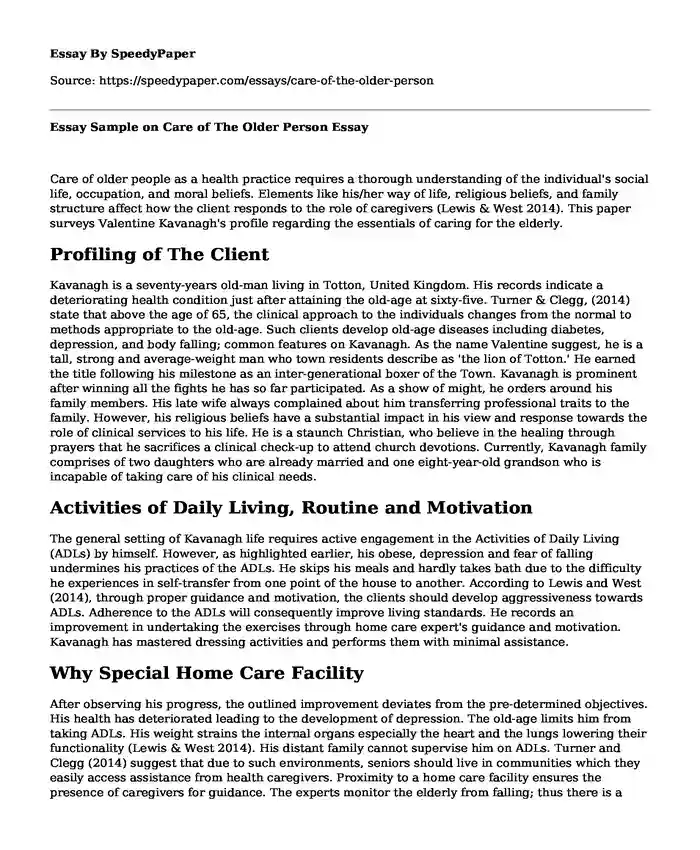
| Type of paper: | Essay |
| Categories: | Healthcare Human services |
| Pages: | 3 |
| Wordcount: | 643 words |
Care of older people as a health practice requires a thorough understanding of the individual's social life, occupation, and moral beliefs. Elements like his/her way of life, religious beliefs, and family structure affect how the client responds to the role of caregivers (Lewis & West 2014). This paper surveys Valentine Kavanagh's profile regarding the essentials of caring for the elderly.
Profiling of The Client
Kavanagh is a seventy-years old-man living in Totton, United Kingdom. His records indicate a deteriorating health condition just after attaining the old-age at sixty-five. Turner & Clegg, (2014) state that above the age of 65, the clinical approach to the individuals changes from the normal to methods appropriate to the old-age. Such clients develop old-age diseases including diabetes, depression, and body falling; common features on Kavanagh. As the name Valentine suggest, he is a tall, strong and average-weight man who town residents describe as 'the lion of Totton.' He earned the title following his milestone as an inter-generational boxer of the Town. Kavanagh is prominent after winning all the fights he has so far participated. As a show of might, he orders around his family members. His late wife always complained about him transferring professional traits to the family. However, his religious beliefs have a substantial impact in his view and response towards the role of clinical services to his life. He is a staunch Christian, who believe in the healing through prayers that he sacrifices a clinical check-up to attend church devotions. Currently, Kavanagh family comprises of two daughters who are already married and one eight-year-old grandson who is incapable of taking care of his clinical needs.
Activities of Daily Living, Routine and Motivation
The general setting of Kavanagh life requires active engagement in the Activities of Daily Living (ADLs) by himself. However, as highlighted earlier, his obese, depression and fear of falling undermines his practices of the ADLs. He skips his meals and hardly takes bath due to the difficulty he experiences in self-transfer from one point of the house to another. According to Lewis and West (2014), through proper guidance and motivation, the clients should develop aggressiveness towards ADLs. Adherence to the ADLs will consequently improve living standards. He records an improvement in undertaking the exercises through home care expert's guidance and motivation. Kavanagh has mastered dressing activities and performs them with minimal assistance.
Why Special Home Care Facility
After observing his progress, the outlined improvement deviates from the pre-determined objectives. His health has deteriorated leading to the development of depression. The old-age limits him from taking ADLs. His weight strains the internal organs especially the heart and the lungs lowering their functionality (Lewis & West 2014). His distant family cannot supervise him on ADLs. Turner and Clegg (2014) suggest that due to such environments, seniors should live in communities which they easily access assistance from health caregivers. Proximity to a home care facility ensures the presence of caregivers for guidance. The experts monitor the elderly from falling; thus there is a need to take him to a special home care facility which would accelerate his boy response to the ADLs. Due to their commitments, his two daughters gladly welcome the decision and even provides financial support to the initiative.
Conclusion
Family structure and personality of the elderly affects how he/she perceives the clinical exercises. Strong religious beliefs and absence of clinical support members undermine the clinical activities of the individual. Therefore, the performance of the ADLs by the elderly should need support from culturally competent clinical experts.
References
Turner, G. and Clegg, A., 2014. Best practice guidelines for the management of frailty: a British Geriatrics Society, Age UK and Royal College of General Practitioners report. Age and ageing, 43(6), pp.744-747.
Lewis, J. and West, A., 2014. Re-shaping social care services for older people in England: policy development and the problem of achieving 'good care'. Journal of Social Policy, 43(1), pp.1-18.
Cite this page
Essay Sample on Care of The Older Person. (2022, Nov 11). Retrieved from http://land-repo.site.supplies/essays/care-of-the-older-person?pname=speedypaper.com
Request Removal
If you are the original author of this essay and no longer wish to have it published on the SpeedyPaper website, please click below to request its removal:
- Essay Sample on Abortion: The Silent Scream
- Rhetorical Appeals Essay Sample
- PR Essay Example: Evaluation and Review
- Essay Example on English Dialects
- Healthcare Marketing Essay Sample
- Essay Sample on Interventions on Reducing HCV Prevalence in the Incarcerated Population
- Essay Sample on Eviction of Tenants in Utah
Popular categories




